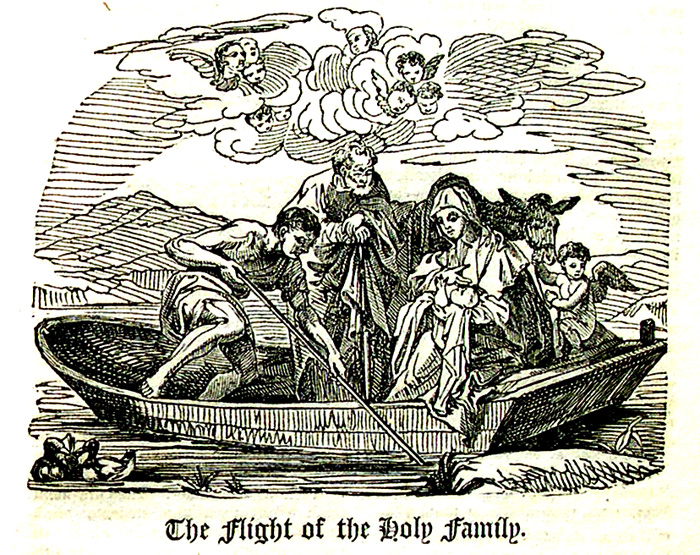December 28.
The Holy Innocents. St. Theodorus, Abbot of Tabenna, A. D. 367.
Innocents.This is another Romish celebration preserved in the church of England calendar and the almanacs. It has another name—
Childermas-Day.This is conjectured to have been derived from the masses said for the souls of the Innocents who suffered from Herod's cruelty. It is to commemorate their slaughter that Innocents or Childermas-day is appropriated, and hence the name it bears.
It was formerly a custom to whip up the children on Innocent's day morning, in order "that the memorial of Herod's murder of the Innocents might stick the closer, and so, in a moderate proportion, to act over the crueltie again in kinde."*[1] The day itself was deemed of especial ill omen, and hence the superstitious never married on Childermas-day. Neither upon this day was it "lucky" to put on new clothes, or pare the nails, or begin any thing of moment. In the play of "Sir John Oldcastle" the prevalence of this belief is instanced by an objection urged to an expedition proposed on a Friday,—"Friday, quoth'a, a dismal day; Candlemas-day this year was Friday." This vulgar superstition reached the throne; the coronation of king Edward IV. was put off till the Monday, because the preceding Sunday was Childermas-day.[2]† Lastly, a mother in the "Spectator" is made to say, at that time, "No, child, if it please God, you shall not go into join-hand on Childermas-day."
Yet this was a day of disport among the sages of the law. In 1517, king Henry VIII., by an order, enjoined, "that the king of cockneys, on Childermas-day, should sit and have due service; and that he and all his officers should use honest manner and good order, without any waste or destruction making in wine, brawn, chely, or other vitails: and also that he, and his marshal, butler, and constable marshal, should have their lawful and honest commandments by delivery of the officers of Christmas, and that the said king of cockneys, ne none of his officers medyl neither in the buttery, nor in the Stuard of Christmass his office, upon pain of 40s. for every such medling: and lastly, that Jack Straw, and all his adherents, should be thenceforth utterly banisht and no more to be used in this house, upon pain to forfeit, for every time, five pounds, to be levied on every fellow hapning to offend against this rule."*[3]
The Flight of the Holy Family.From Herod's cruel order, they
By angel's order, fled away,
And painters add, an angel, too,
Attended them the journey through.
The old artists often painted the flight of the holy family from Herod's cruel purpose:—"Behold the angel of the lord appeared to Joseph in a dream, saying, Arise, and take the young child and his mother, and flee into Egypt, and be thou there until I bring thee word: for Herod will seek the young child to destroy him. When he arose he took the young child and his mother by night, and departed into Egypt, and was there until the death of Herod."*[4] In some pictures an angel is painted accompanying them on the way, although on no scriptural authority. In a painting by "Lucca Giordano" they are represented in a boat with the ass, whereon the virgin had rode, held by an angel, who is thus degraded to the condition of a stable boy; while cherubs company them in the sky: the picture being curious and engraving from it is placed in this article.
Lucca Giordano.
The artist of the picture mentioned was born at Naples, about 1629: he studied under Spagnoletto, and afterwards under Pietra da Cortona. He is likewise called Luca Fa Presto, from a phrase used by his father. Though his son painted with amazing facility, from designs of the great masters, while he pursued his studies, and the old man sold them for high prices, yet he was accustomed to hurry his son at his meals as well as his work, and say, "Luca fa presto!" Luca, make haste: hence, Luca's companions nicknamed him Fa Presto. His knowledge of the style of artists belonging to different schools was amazing, and though his attainments in judgment and execution were of high order, he seems to have preferred the copying of other compositions to painting designs by himself. Hence, there are more pictures by Luca fa Presto than some connoisseurs would willingly acknowledge. They pervade every collection under the reputation of being by Titian, Guido, Tintorette, and other painters of greater celebrity than Giordano. He etched his own thoughts freely and gracefully, and died loaded with honours from crowned heads, and immensely rich, in 1704.
FLORAL DIRECTORY.
Bloody Heath. Erica cruenta.
Dedicated to The Holy Innocents.
